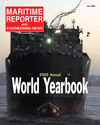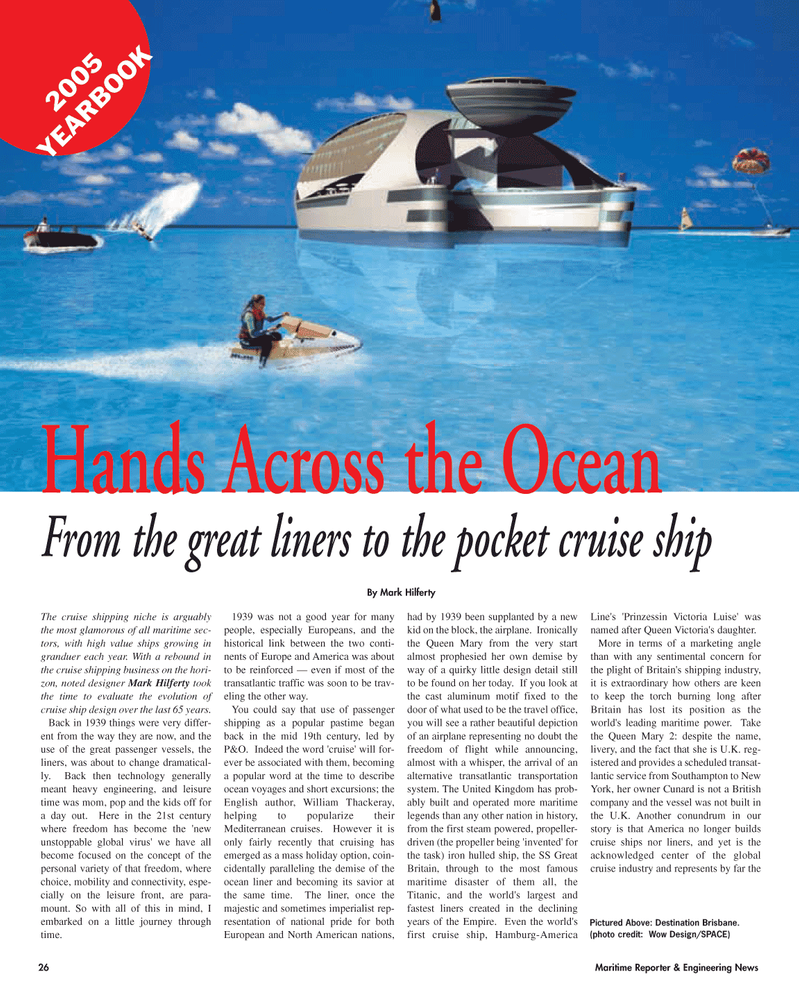
Page 26: of Maritime Reporter Magazine (June 2005)
Annual World Yearbook
Read this page in Pdf, Flash or Html5 edition of June 2005 Maritime Reporter Magazine
The cruise shipping niche is arguably the most glamorous of all maritime sec- tors, with high value ships growing in granduer each year. With a rebound in the cruise shipping business on the hori- zon, noted designer Mark Hilferty took the time to evaluate the evolution of cruise ship design over the last 65 years.
Back in 1939 things were very differ- ent from the way they are now, and the use of the great passenger vessels, the liners, was about to change dramatical- ly. Back then technology generally meant heavy engineering, and leisure time was mom, pop and the kids off for a day out. Here in the 21st century where freedom has become the 'new unstoppable global virus' we have all become focused on the concept of the personal variety of that freedom, where choice, mobility and connectivity, espe- cially on the leisure front, are para- mount. So with all of this in mind, I embarked on a little journey through time. 1939 was not a good year for many people, especially Europeans, and the historical link between the two conti- nents of Europe and America was about to be reinforced — even if most of the transatlantic traffic was soon to be trav- eling the other way.
You could say that use of passenger shipping as a popular pastime began back in the mid 19th century, led by
P&O. Indeed the word 'cruise' will for- ever be associated with them, becoming a popular word at the time to describe ocean voyages and short excursions; the
English author, William Thackeray, helping to popularize their
Mediterranean cruises. However it is only fairly recently that cruising has emerged as a mass holiday option, coin- cidentally paralleling the demise of the ocean liner and becoming its savior at the same time. The liner, once the majestic and sometimes imperialist rep- resentation of national pride for both
European and North American nations, had by 1939 been supplanted by a new kid on the block, the airplane. Ironically the Queen Mary from the very start almost prophesied her own demise by way of a quirky little design detail still to be found on her today. If you look at the cast aluminum motif fixed to the door of what used to be the travel office, you will see a rather beautiful depiction of an airplane representing no doubt the freedom of flight while announcing, almost with a whisper, the arrival of an alternative transatlantic transportation system. The United Kingdom has prob- ably built and operated more maritime legends than any other nation in history, from the first steam powered, propeller- driven (the propeller being 'invented' for the task) iron hulled ship, the SS Great
Britain, through to the most famous maritime disaster of them all, the
Titanic, and the world's largest and fastest liners created in the declining years of the Empire. Even the world's first cruise ship, Hamburg-America
Line's 'Prinzessin Victoria Luise' was named after Queen Victoria's daughter.
More in terms of a marketing angle than with any sentimental concern for the plight of Britain's shipping industry, it is extraordinary how others are keen to keep the torch burning long after
Britain has lost its position as the world's leading maritime power. Take the Queen Mary 2: despite the name, livery, and the fact that she is U.K. reg- istered and provides a scheduled transat- lantic service from Southampton to New
York, her owner Cunard is not a British company and the vessel was not built in the U.K. Another conundrum in our story is that America no longer builds cruise ships nor liners, and yet is the acknowledged center of the global cruise industry and represents by far the 2005
YEARBOOK 26 Maritime Reporter & Engineering News
Hands Across the Ocean
From the great liners to the pocket cruise ship
By Mark Hilferty
Pictured Above: Destination Brisbane. (photo credit: Wow Design/SPACE)
MR JUNE 2005 #4 (25-32).qxd 6/2/2005 7:04 PM Page 26

 25
25

 27
27
